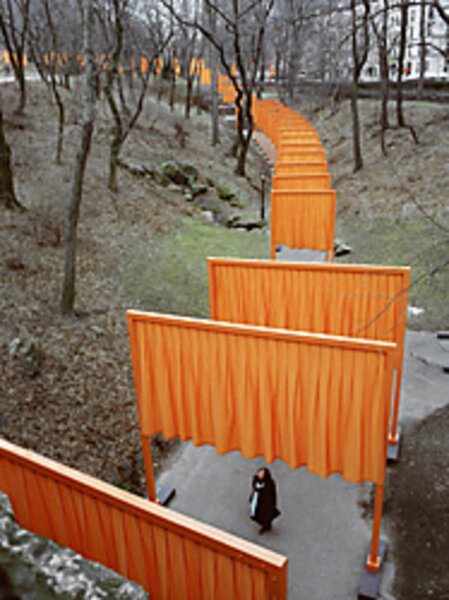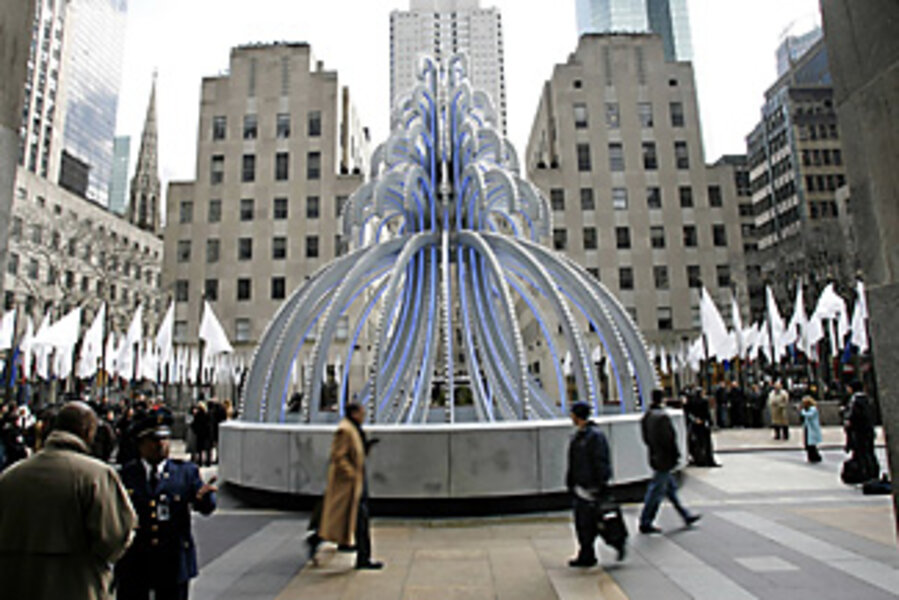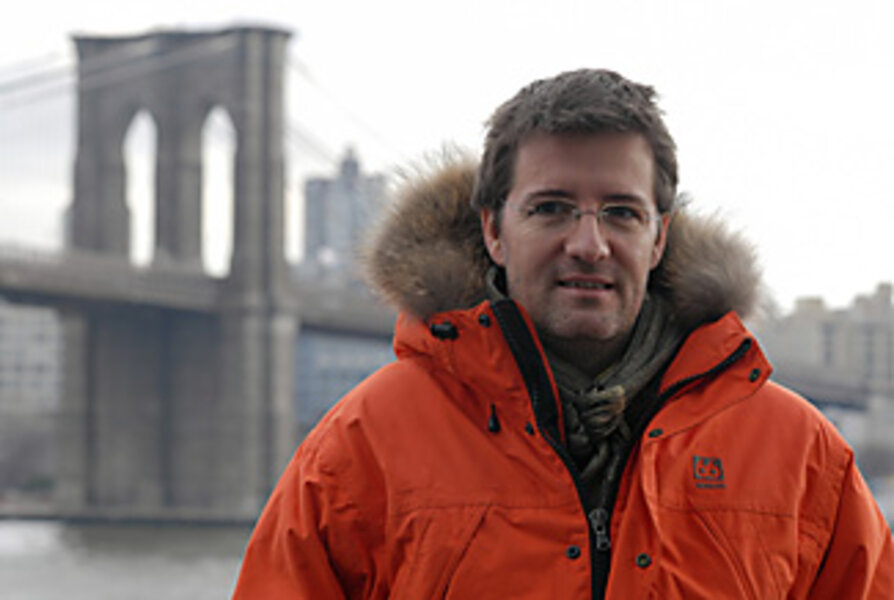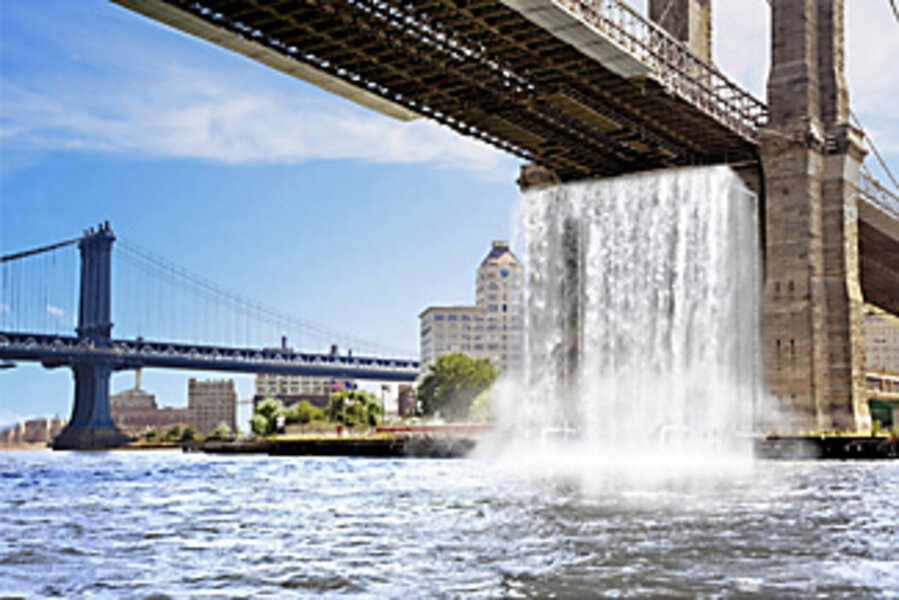Turning cities into art galleries
| New York
For more than a century, the majestic Brooklyn Bridge has straddled the East River, linking the piers of lower Manhattan to the brownstones of Brooklyn Heights.
Now, under the hand of the Danish-born artist Olafur Eliasson, the national monument is passing into a second, and temporary, phase: that of hulking, stone-and-steel canvas.
Beginning this month, the Tishman Construction Corporation will install four electrically powered waterfalls, arranged on skeletons of exposed scaffolding and ranging in height from 90 to 120 ft. One installation is scheduled for Governors Island in New York Harbor; two more will sit on either side of the East River, in Brooklyn and Manhattan. The fourth will be mounted on the underside of the Brooklyn Bridge.
In an e-mail message, Mr. Eliasson said he hopes the scale of "New York City Waterfalls" – among the most ambitious projects in recent memory – could help spur a revitalization of New York's waterfront.
There "have been attempts, of course," he says, "but I want to push that further." If it is a triumph, "Waterfalls" could prompt tourists – and hardened New Yorkers – to reengage with one of the world's most iconic skylines.
"Waterfalls" also ushers in deeper questions about the role of public art in urban life. Apart from the inevitable flood of media attention, how do we judge whether a public project has been successful? The ultimate test, experts say, may be a work's ability to forge connections – by reaching out to its viewers and engaging them in their environment.
Historically, public art has forced "you to reconsider your relationship to that site. It shocks you out of your complacency," says Noah Chasin, assistant professor of Art History at Bard College in Annandale-on-Hudson, N.Y.
Rochelle Steiner, director of New York's Public Art Fund, a major backer of "Waterfalls," hopes Eliasson's project has precisely that effect: "People will think about the city, the East River, and nature – particularly water as a natural resource – differently after having seen them."
Eliasson likes to tweak perceptions on a large scale. His best-known work, a 2004 installation at London's Tate Modern titled "The Weather Project," toyed with the illusory power of artificial light. Ms. Steiner, who is also the curator of "Waterfalls," describes it as "an insertion of 'nature' into the urban conditions of the city."
Thinking fiscally
For a city, of course, success is often gauged in more tangible terms: Public-art projects can generate an incredible amount of community revenue.
In 2005, for instance, the European artists Christo and Jeanne-Claude erected more than 7,500 saffron-colored nylon banners across Central Park for two weeks. According to Kate Levin, commissioner at New York's Department of Cultural Affairs, "The Gates" generated approximately $254 million.
"New York City Waterfalls" is expected to bring New York roughly $55 million over three months – a figure based on tax revenues "that the city would not get otherwise," says Ms. Levin. The figure includes tourism-related spending and income from increased use of public transportation near the site.
Eliasson and the city are also hoping to usher in long-term financial benefits that may be harder to quantify. Consider: The stretch of Manhattan abutting the East River has historically been thought less desirable than the opposite bank of the island. A waterfall constructed on Pier 35, near Rutgers St., will, Eliasson hopes, prod visitors to contemplate the developmental viability of the area.
"New York City is an island city, and our waterfront has for a long time been neglected," Levin says. "Waterfalls," may help pull foot traffic toward the East River.
"Waterfalls are spectacular in themselves. In that way they suit the skyline," Eliasson says.
The next question: "Can we go beyond the spectacle?"
Trafficking in the spectacular
Yet public-art projects are just as often almost purely spectacle. The most recent example: "Electric Fountain," a sculpture installed in February by British artists Tim Noble and Sue Webster. (It is set for deconstruction April 4.)
Even by the gaudy standards of Rockefeller Center, home to the "Today Show" and America's most famous Christmas tree, "Electric Fountain" is a study in extravagance. Reaching 35 ft. in height, and lit by a fusillade of LED bulbs, the 61,000-pound sculpture was designed to evoke a sense of "otherness."
"Bringing space to life for the individual or for small groups – to me that's the foundation of building communities," says Christopher Janney, a public artist near Boston. Mr. Janney, who works with light and sound installations, says his primary consideration is how to enliven an otherwise ordinary space. He is currently at work on the facade of a 12-story parking deck in Fort Worth, Texas.
A complex practice
But Janney and others are quick to point to the ways in which public art can be unsettling or disruptive. Many art lovers remember Richard Serra's infamous "Tilted Arc," a magnificent wall of undulating steel that bisected Federal Plaza in lower Manhattan. Almost immediately, office workers were in an uproar. In 1989, eight years after its installation, the $175,000 commission was removed and junked. Serra had intended the piece to be permanent.
"That really marked a sea change," says Robin Cembalest, executive editor of ARTnews magazine. "Even though it's understood that you're not going to find a piece that all people will like, there's a real sense of trying to make art something the public can connect with – even if it might have some kind of edge."
Acknowledging the complexities a public artist must navigate, more art schools, such as USC's Roski School of Fine Arts in Los Angeles, are offering programs in public-art studies and practice. "They recognize it is a discipline that requires special training," says Janney.
Public art is markedly different from a private gallery show, admits Steiner, since it can "make ripples in the life of a city and impact people who see it."
One of the intentions of "Waterfalls," she says, "is to intervene in the city such that people are inspired to reconsider their environment, both built and natural."








